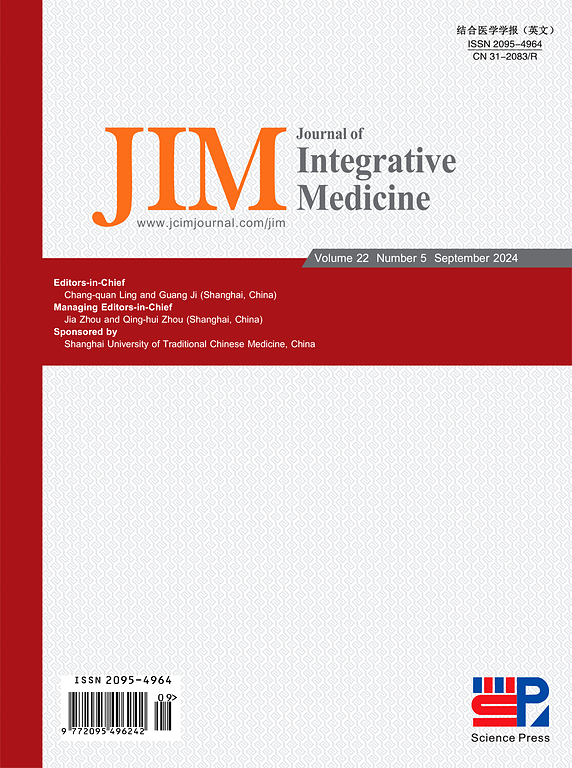针刺通过α7nAChR-JAK2/STAT3通路激活迷走神经-巨噬细胞轴,改善心房颤动大鼠心脏电生理和炎症反应。
IF 4
2区 医学
Q1 INTEGRATIVE & COMPLEMENTARY MEDICINE
引用次数: 0
摘要
目的:心房颤动(AF)的发生和发展受自主神经系统和炎症的影响。针刺是治疗房颤的有效方法。本研究探讨针刺对阵发性房颤大鼠模型的保护作用,并探讨其机制。方法:雄性Sprague-Dawley大鼠130只,随机分为空白对照组(Con)、假手术组(sham)、AF组(AF)和针刺治疗组(Acu)。采用颈静脉快速心房起搏法建立阵发性房颤模型。Acu组大鼠固定于内关穴(PC6),每日20 min,连续7 d。其他组在治疗期间固定相同时间,但不接受针灸。通过监测体表心电图和迷走神经放电信号,评估AF诱导率、AF持续时间、心电生理参数和心率变异性。干预后对大鼠实施安乐死,采用苏木精和伊红染色评价心房形态。采用免疫组织化学、免疫荧光和流式细胞术检测心房心肌组织巨噬细胞F4/80抗原(F4/80)和分化簇(cd86)的表达。采用Western blotting、逆转录-定量聚合酶链反应或酶联免疫吸附法检测心房心肌组织中白细胞介素(IL)-1β、IL-6、肿瘤坏死因子-α (TNF-α)、α7烟碱胆碱受体(α7nAChR)、磷酸化Janus激酶2 (p-JAK2)、磷酸化信号转导和转录激活因子3 (p-STAT3)的表达水平或含量。通过腹腔注射α7nAChR拮抗剂甲基莱卡乌碱(MLA)验证α7nAChR在针刺治疗中的作用。结果:与房颤组比较,针刺可显著缩短房颤持续时间和诱导率,通过增强迷走神经活动和调节自主神经平衡改善心电生理。降低促炎M1巨噬细胞比例,减轻心肌损伤和浸润。MLA减弱了针刺的电生理改善和抗炎作用。提示针刺可触发α7nAChR-JAK2/STAT3通路,通过神经免疫调节发挥心脏保护作用。结论:针刺可显著降低阵发性AF大鼠AF诱导率,缩短AF持续时间,改善心脏电生理参数,增强迷走神经活性,降低促炎M1巨噬细胞及炎症因子的表达,其积极作用与α 7nachr介导的JAK2/STAT3信号通路的激活有关。表明心脏迷走神经与巨噬细胞之间的相互作用可能是针刺预防和治疗房颤的潜在靶点。本文署名:李振华,杨文明,黄强,石桂霞,刘长忠,张永强。针刺通过α7nAChR-JAK2/STAT3通路激活迷走神经-巨噬细胞轴,改善心房颤动大鼠心脏电生理和炎症反应。集成医学[J];打印前Epub。本文章由计算机程序翻译,如有差异,请以英文原文为准。
Acupuncture activates vagus nerve-macrophage axis and improves cardiac electrophysiology and inflammatory response in rats with atrial fibrillation via α7nAChR-JAK2/STAT3 pathway
Objective
The occurrence and development of atrial fibrillation (AF) are influenced by the autonomic nervous system and inflammation. Acupuncture is an effective treatment for AF. This study explored the protective effects of acupuncture in a rat model of paroxysmal AF and investigated its mechanisms.
Methods
Male Sprague-Dawley rats (n = 130) were randomly divided into blank control (Con), sham operation (Sham), AF, and acupuncture treatment (Acu) groups. A paroxysmal AF model was established by rapid atrial pacing through the jugular vein. Rats in the Acu group were immobilized to receive acupuncture treatment at Neiguan acupoint (PC6) for 20 min daily for seven days. The other groups were immobilized for the same duration over the treatment period but did not receive acupuncture. The AF induction rate, AF duration, cardiac electrophysiological parameters, and heart rate variability were evaluated by monitoring surface electrocardiogram and vagus nerve discharge signals. After the intervention, the rats were euthanized, and atrial morphology was assessed using haematoxylin and eosin staining. The expression of macrophage F4/80 antigen (F4/80) and cluster of differentiation (CD) 86 in atrial myocardial tissue was detected using immunohistochemistry, immunofluorescence and flow cytometry. The expression levels or contents of interleukin (IL)-1β, IL-6, tumor necrosis factor-α (TNF-α), α7 nicotinic acetylcholine receptor (α7nAChR), phosphorylated Janus kinase 2 (p-JAK2), and phosphorylated signal transducer and activator of transcription 3 (p-STAT3) in atrial myocardial tissue were detected using Western blotting, reverse transcription-quantitative polymerase chain reaction, or enzyme-linked immunosorbent assay. The role of α7nAChR in acupuncture treatment was verified by intraperitoneal injection of the α7nAChR antagonist methyllycaconitine (MLA).
Results
Compared with the AF group, acupuncture significantly reduced AF duration and induction rate, improved cardiac electrophysiology by enhancing vagus nerve activity and regulating autonomic balance. It also decreased the pro-inflammatory M1 macrophage proportion, alleviating myocardial injury and infiltration. MLA weakened acupuncture’s electrophysiological improvement and anti-inflammatory effect. Results suggest that acupuncture triggers the α7nAChR-JAK2/STAT3 pathway and exerts cardioprotection via neuroimmune regulation.
Conclusion
Acupuncture significantly reduced the AF induction rate, shortened AF duration, improved cardiac electrophysiological parameters, enhanced vagus nerve activity, and decreased the expression of pro-inflammatory M1 macrophages and inflammatory factors in rats with paroxysmal AF. Its positive effects are related to the activation of the α7nAChR-mediated JAK2/STAT3 signalling pathway, indicating that the interaction between cardiac vagus nerve and macrophages may be a potential target for acupuncture in the prevention and treatment of AF.
Please cite this article as: Li ZH, Yang WM, Huang Q, Shi GX, Liu CZ, Zhang YQ. Acupuncture activates vagus nerve-macrophage axis and improves cardiac electrophysiology and inflammatory response in rats with atrial fibrillation via α7nAChR-JAK2/STAT3 pathway. J Integr Med. 2025; 23(4): 398–414.
求助全文
通过发布文献求助,成功后即可免费获取论文全文。
去求助
来源期刊

Journal of Integrative Medicine-Jim
Medicine-Complementary and Alternative Medicine
CiteScore
9.20
自引率
4.20%
发文量
3319
期刊介绍:
The predecessor of JIM is the Journal of Chinese Integrative Medicine (Zhong Xi Yi Jie He Xue Bao). With this new, English-language publication, we are committed to make JIM an international platform for publishing high-quality papers on complementary and alternative medicine (CAM) and an open forum in which the different professions and international scholarly communities can exchange views, share research and their clinical experience, discuss CAM education, and confer about issues and problems in our various disciplines and in CAM as a whole in order to promote integrative medicine.
JIM is indexed/abstracted in: MEDLINE/PubMed, ScienceDirect, Emerging Sources Citation Index (ESCI), Scopus, Embase, Chemical Abstracts (CA), CAB Abstracts, EBSCO, WPRIM, JST China, Chinese Science Citation Database (CSCD), and China National Knowledge Infrastructure (CNKI).
JIM Editorial Office uses ThomsonReuters ScholarOne Manuscripts as submitting and review system (submission link: http://mc03.manuscriptcentral.com/jcim-en).
JIM is published bimonthly. Manuscripts submitted to JIM should be written in English. Article types include but are not limited to randomized controlled and pragmatic trials, translational and patient-centered effectiveness outcome studies, case series and reports, clinical trial protocols, preclinical and basic science studies, systematic reviews and meta-analyses, papers on methodology and CAM history or education, conference proceedings, editorials, commentaries, short communications, book reviews, and letters to the editor.
Our purpose is to publish a prestigious international journal for studies in integrative medicine. To achieve this aim, we seek to publish high-quality papers on any aspects of integrative medicine, such as acupuncture and traditional Chinese medicine, Ayurveda medicine, herbal medicine, homeopathy, nutrition, chiropractic, mind-body medicine, taichi, qigong, meditation, and any other modalities of CAM; our commitment to international scope ensures that research and progress from all regions of the world are widely covered. These ensure that articles published in JIM have the maximum exposure to the international scholarly community.
JIM can help its authors let their papers reach the widest possible range of readers, and let all those who share an interest in their research field be concerned with their study.
 求助内容:
求助内容: 应助结果提醒方式:
应助结果提醒方式:


